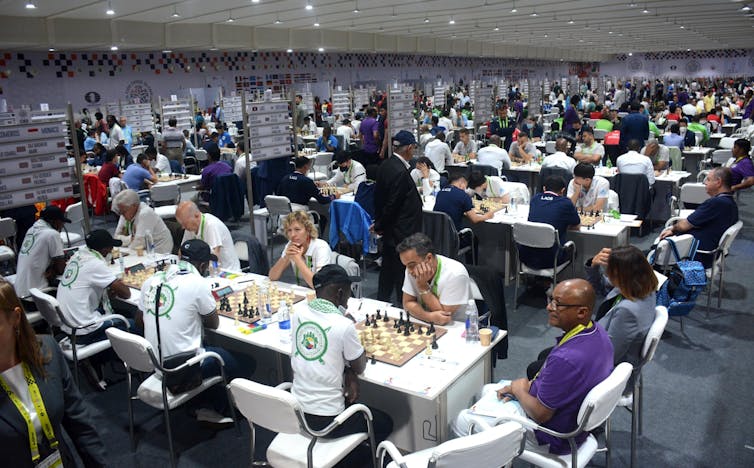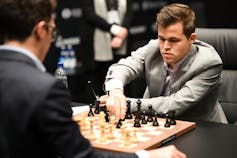Why Canada should invest more in teaching kids how to play chess
Chess has been in the news more than usual lately. First, there was the resounding success of the Netflix miniseries The Queen’s Gambit. That made checkerboards the new toilet paper as retailers and manufacturers struggled to keep up with demand. Now a high profile cheating scandal is rocking the chess world.
But amidst those headlines, the best recent chess news for Canadians is the quieter story of Shawn Rodrigue-Lemieux, a Quebec teenager who recently won the World U18 Chess Championship: the first time for a Quebecer and only the second time for a Canadian.
Unlike the cheating scandal and the fictional depiction of chess in The Queen’s Gambit, the story of Rodrigue-Lemieux is clearly good and genuine. It should inspire and motivate us as a nation to invest more in chess so that its performance will lead to more Canadian success in international competitions.
Success at the highest chess level costs money. Investing in chess as a sport and as a compulsory subject in schools would be money well spent.

(AP photo)
chess as a sport
This year, Sport Canada supported hockey in Canada with nearly $7 million. It has allocated an additional $1.5 million to individual hockey players as part of its Athlete Assistance Program. But Sport Canada isn’t just generous to hockey. There’s more than $300,000 in bowling; $5.2 million for curling; $200,000 for surfing; over $1 million for cricket; nearly $700,000 for Ringette; about $250,000 for skateboarding; and more than $500,000 for archery.
What does Sport Canada get for chess? Nothing.
According to Sport Canada, chess is not eligible for a sport sponsorship for the simple reason that chess is not a sport. But chess meets every single criterion for being a sport except one: it’s not considered a physical activity. It’s just a “game of skill,” a board game like Monopoly or Scrabble that requires mental effort but no physical physical effort.
Sport Canada’s position on chess may be shared by many Canadians, but it is incorrect for at least two reasons and not consistent with the position of many other nations.
In 1999, the International Olympic Committee recognized chess as a sport for the first time. Chess was even featured as an exhibition event at the Sydney 2000 Olympic Games. There were efforts to bring chess to the Paris 2024 Olympics, but this was rejected.
When the time comes and chess plays a role in the Olympics, Canada will not be ready to compete unless we start funding chess now.

(Shutterstock)
Second, contrary to Sport Canada’s naïve position, chess, when played at the highest level, is actually a physical activity. In an interview with the BBC in 2014, the greatest chess player of all time and reigning world champion Magnus Carlsen revealed: “To me, chess is a sport first and an art and science second.”
Carlsen attributed two of his victories over former world champion Vishy Anand to his superior athletics rather than superior chess play. The games were long and, according to Carlsen, “were very much decided by physical strength in the fifth and sixth hours.”
Invest in chess
The wisest way for Canada to invest in chess would be to follow the example of other nations, including Spain, Armenia and Georgia, which have made chess a compulsory subject in elementary or high school.
The arguments for including chess in school curricula are usually based on the benefits to improving math skills. But that’s not the only advantage of chess.
Chess is a prime example of an interdisciplinary activity. The greatest chess players in history had one thing in common: they saw chess as something much more serious than a game. The first official champion, Wilhelm Steinitz, declared that chess was a science and wrote a treatise on the principles of that science. The next champion, Emanuel Lasker, saw chess as a perfect model for every human struggle.

(Shutterstock)
Another champion, Alexander Alekhine, thought chess was an art, an opinion echoed by one of the world’s most famous artists, Marcel Duchamp, who quit making art to concentrate on chess. Computer scientists often turn to chess as a test for artificial intelligence. And former world champion Garry Kasparov has taken all these insights and written a book arguing that chess is a model for all aspects of life.
Teaching chess in Canadian schools would teach children to see the unity of all other disciplines they are learning in school. It would challenge them to use their minds and yes, even their bodies to learn, compete and have fun. While chess is in the spotlight, we shouldn’t miss this opportunity to build on the enthusiasm for chess that exists in Canada.